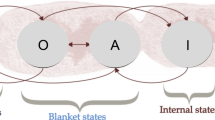Abstract
The existence of superstition and religious beliefs in most, if not all, human societies is puzzling for behavioral ecology. These phenomena bring about various fitness costs ranging from burial objects to celibacy, and these costs are not outweighed by any obvious benefits. In an attempt to resolve this problem, we present a verbal model describing how humans and other organisms learn from the observation of coincidence (associative learning). As in statistical analysis, learning organisms need rules to distinguish between real patterns and randomness. These rules, which we argue are equivalent to setting the level of α for rejection of the null hypothesis in statistics, are governed by risk management as well as by comparison to previous experiences. Risk management means that the cost of a possible type I error (superstition) has to be traded off against the cost of a possible type II error (ignorance). This trade-off implies that the occurrence of superstitious beliefs is an inevitable consequence of an organism’s ability to learn from observation of coincidence. Comparison with previous experiences (as in Bayesian statistics) improves the chances of making the right decision. While this Bayesian approach is found in most learning organisms, humans have evolved a unique ability to judge from experiences whether a candidate subject has the power to mechanistically cause the observed effect. Such “strong” causal thinking evolved because it allowed humans to understand and manipulate their environment. Strong causal thinking, however, involves the generation of hypotheses about underlying mechanisms (i.e., beliefs). Assuming that natural selection has favored individuals that learn quicker and more successfully than others owing to (1) active search to detect patterns and (2) the desire to explain these patterns mechanistically, we suggest that superstition has evolved as a by-product of the first, and that belief has evolved as a by-product of the second.
Similar content being viewed by others
References
Anderson, J. R. 1990The Adaptive Character of Thought. Hillsdale, NJ: Lawrence Erlbaum Associates.
Boshier, R. 1973 An Empirical Investigation of the Relationship between Conservatism and Superstition.British Journal of Social and Clinical Psychology 12:262–267.
Boyer, P. 1994The Naturalness of Religious Ideas: A Cognitive Theory about Religion. Berkeley: University of California Press.
Camus, A. 1942Le mythe de Sisyphe: essai sur l’absurde. Paris: Gallimard.
Catania, A. C., and D. Cutts 1963 Experimental Control of Superstitious Responding in Humans.Journal of the Experimental Analysis of Behaviour 6:203–208.
Cheng, P. W. 1997 From Covariation to Causation: A Causal Power Theory.Psychological Review 104:367–405.
Dawkins, R. 1998Unweaving the Rainbow. Boston: Mariner Books.
Frazer, J. G. 1922The Golden Bough: A Study in Magic and Religion. New York: Macmillan.
Fugelsang, J. A., and K. N. Dunbar 2004 A Cognitive Neuroscience Framework for Understanding Causal Reasoning and the Law.Philosophical Transactions of the Royal Society of London B 359:1749–1754.
Garcia, J., and R. A. Koelling 1966 Relation of Cue to Consequence in Avoidance Learning.Psychonomic Science 4:123–124.
Gigerenzer, G., and P. M. Todd 1999Simple Heuristics That Make Us Smart. New York: Oxford University Press.
Glymoure, C., and P. W. Cheng 1998 Causal Mechanism and Probablitity: A Normative Approach. InRational Models of Cognition, M. Oaksford and N. Chater, eds. Pp. 295–313. Oxford: Oxford University Press.
Green, D. M., and J. A. Swets 1974Signal Detection Theory and Psychophysics. Huntington, NY: Robert E. Krieger.
Higgins, S. T., E. K. Morris, and L. M. Johnson 1989 Social Transmission of Superstitious Behavior in Preschool Children.Psychological Record 39:307–323.
Killeen, P. R. 1978 Superstition: A Matter of Bias, Not Detectability.Science 199:88–90.
Kummer, H. 1995 Causal Knowledge in Animals. InCausal Cognition, D. Sperber, D. Premack, and A. J. Premack, eds. Pp. 26–37. Oxford: Clarendon.
Malakoff, D. 1999 Bayes Offers a “New” Way to Make Sense of Numbers.Science 286:1460–1464.
Matsuzawa, T., Y. Hasegawa, S. Gotoh, and K. Wada 1983 One-Trial Long-Lasting Food-Aversion Learning in Wild Japanese Monkeys (Macaca fuscata).Behavioral and Neural Biology 39:155–159.
McGonigle, B., and M. Chalmers 1998 Rationality as Optimized Cognitive Self-regulation. InRational Models of Cognition, M. Oaksford and N. Chater, eds. Pp. 501–534. Oxford: Oxford University Press.
Mineka, S., and M. Cook 1988 Social Learning and the Acquisition of Snake Fear in Monkeys. InSocial Learning: Psychological and Biological Perspectives, T. R. Zentall and B. G. Galef Jr., eds. Pp. 51–73. Hillsdale, NJ: Lawrence Erlbaum Associates.
Morse, W. H., and B. F. Skinner 1957 A Second Type of Superstition in the Pigeon.American Journal of Psychology 70:308–311.
Ninness, H. A. C., and S. K. Ninness 1999 Contingencies of Superstition: Self-generated Rules and Responding during Second-Order Response-Independent Schedules.Psychological Record 49:211–243.
Ono, K. 1987 Superstitious Behavior in Humans.Journal of the Experimental Analysis of Behaviour 47:261–271.
Popper, K., and J. Eccles 1977The Self and Its Brain—An Argument for Interactionism. Berlin: Springer.
Rudski, J. M., M. I. Lischner, and L. M. Albert 1999 Superstitious Rule Generation Is Affected by Probability and Type of Outcome.Psychological Record 49:245–260.
Scheibe, K. E., and T. R. Sorbin 1965 Towards a Theoretical Conceptualization of Superstition.British Journal for the Philosophy of Science 16:143–158.
Skinner, B. F. 1948 “Superstition” in the Pigeon.Journal of Experimental Psychology 38:168–172.
Tomasello, M. 1999The Cultural Origins of Human Cognition. Cambridge, MA: Harvard University Press.
Valone, T. J. 2006 Are Animals Capable of Bayesian Updating? An Empirical Review.Oikos 112:252–259.
Vyse, S. A. 1997Believing in Magic: The Psychology of Superstition. New York: Oxford University Press.
Wagner, G. A., and E. K. Morris 1987 “Superstitious” Behavior in Children.Psychological Record 37:471–488.
Wilson, E. O. 1998Consilience: The Unity of Knowledge. New York: Alfred A. Knopf.
Wolpert, L. 2003 Causal Belief and the Origins of Technology.Philosophical Transactions of the Royal Society of London A 361:1709–1719.
Author information
Authors and Affiliations
Corresponding author
Rights and permissions
About this article
Cite this article
Beck, J., Forstmeier, W. Superstition and belief as inevitable by-products of an adaptive learning strategy. Hum Nat 18, 35–46 (2007). https://doi.org/10.1007/BF02820845
Received:
Accepted:
Issue Date:
DOI: https://doi.org/10.1007/BF02820845




